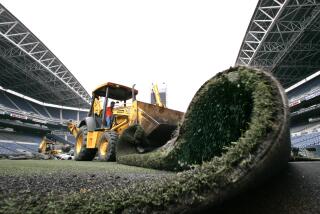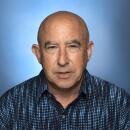Sunny California Buys Into Splendor in the Turf
- Share via
In Southern California, where Mother Nature has long received technological enhancements, the newest fake to take root is one that doesn’t, literally, take root.
It is artificial turf, the stuff famously mocked decades ago by Philadelphia Phillie baseball player Richie Allen, who said: “If a horse won’t eat it, I don’t want to play on it.”
The faux grass is sprouting on public and private campuses from Santa Barbara to Temecula, with high schools, community colleges and youth leagues plunking down $500,000 or more to rip up and replace blotchy and overworked sod fields.
For decades, the surface was a toe-crunching, limb-burning symbol of cities with unforgiving weather, rolled out and glued down in stadiums such as the Houston Astrodome, Louisiana Superdome and New Jersey’s Meadowlands.
But as play space grows scarce and demand soars, officials in Southern California are embracing a new generation of artificial turf, saying it is soft, safe, durable and cost-effective.
“It’s the growth of youth sports,” said Robert Fraisse, superintendent of the Conejo Valley Unified School District in Thousand Oaks. “So many kids are using our fields. Every athletic director says it’s unsafe to have sod turf with all these youth programs.”
School district officials say a synthetic field can save $70,000 annually in water and maintenance costs, ultimately offsetting the steep upfront expense.
“At the end of the day, it will be cost neutral,” said Fraisse, whose district will replace grass with synthetics at its three high schools this summer. “It won’t save us, but the product will be much better. We need a product that can take the wear and tear.”
Since 2001, more than a dozen high schools and community colleges throughout the region have replaced their grass football and soccer fields with the new surfaces; at least a dozen more expect to complete installation this summer or are soliciting bids.
In the Santa Clarita Valley, all four campuses in the William S. Hart Union High School District will put in the fields this summer.
In some cases, school districts flush with construction money from voter-approved bond measures are forming partnerships with youth organizations to pay for the surfaces.
The new fields at Newbury Park, Thousand Oaks and Westlake high schools will be paid for by a $3.1-million donation from the city of Thousand Oaks, $450,000 in school pledges and $1.5 million from bond and redevelopment money.
Each school also will have an all-weather track.
Patrick Murphy, president of Mater Dei High in Santa Ana, said the private school is thrilled by its new synthetic surface, particularly the way it held up during a downpour at a girls’ soccer match.
“It was so funny to watch an event in pouring rain and yet the conditions were perfect,” he said. “So far, the soccer kids rave about it, and the football kids running sprints rave about it. The most important thing is kids are going to play on a consistent field, and it’s going to cut down on injuries.”
The new surfaces, developed in the 1990s, look and feel more like grass than does AstroTurf, which was unveiled at the Astrodome in 1966.
FieldTurf, the best-selling new surface, uses silica sand and rubber granules -- made from pulverized tires -- to cushion the blow when athletes land on it. The individual blades are a polyethylene-polypropylene blend about 2 1/2 inches long and coated with oil to prevent field burns.
There have been no independent, long-term studies comparing injuries on grass fields with those on the new artificial surfaces.
Anecdotal evidence from coaches and trainers, however, suggests that the surfaces cut down on injuries caused by players’ cleats “locking” when they run or pivot.
Eli Hallak, trainer at St. Francis High in La Canada Flintridge, which installed FieldTurf in 2001, said he has seen a decrease of 40% in injuries involving knee damage, ankle sprains and concussions.
“There’s no doubt in my mind the field has made a difference,” he said. “When kids hit that ground, the turf is forgiving, spreading the force out.”
Doak Ostergard, the football trainer at Nebraska, said the program has suffered fewer non-contact anterior cruciate ligament injuries since FieldTurf replaced AstroTurf in 1999.
The fields come with an eight-year guarantee; replacement costs are lower than the original, officials say, because less ground preparation is needed.
But problems do occur.
Ventura High’s field has drainage problems because of an architectural error, athletic director Dave Hess said. The school also has had to clean up food and dog manure left on the field.
Schools have banned sunflower seeds and peanuts on the fields because shells can become embedded and cause cuts.
Some schools say surfaces with a sand base can become too hard after a few years.
And fields can retain heat, prompting Harvard-Westlake High School in North Hollywood to hose down its surface on hot days.
Even so, “It’s already paid massive dividends,” said Audrius Barzdukas, the school’s athletic director. “Following the torrential rains [in February], the grass field would have been destroyed. The benefits outweigh the heat considerations.”
TreePeople, a Los Angeles-based environmental organization, conditionally supports artificial grass.
“We’re watching the research to see if it actually pans out,” TreePeople spokesman Jeff Hohensee said. “Right now, we think it’s a reasonable option.”
Hohensee said the newer surfaces don’t release chemicals to the environment and allow water to soak through, preventing flooding. But he made it clear he is not in favor of synthetic grass becoming “our solution for all landscaping.”
The approximately 30 companies in the synthetic turf business installed nearly 500 fields in North America last year, 242 of them by Montreal-based FieldTurf, said company spokesman Darren Gill.
FieldTurf’s price for a typical high school football/soccer field is $650,000. Grass Valley, Calif.-based SportFields, which is bidding to install fields at six San Jose high schools, charges about $540,000.
“The concept of plastic grass is not very appealing, but it’s amazing the benefits it brings on so many levels,” said Dave Brown, vice president of sales for SportFields, adding that his firm has bid on 12 projects from Santa Barbara to San Diego this month alone.
Fresno State-bound quarterback Sean Norton of Newhall’s Hart High is sold on artificial turf, having played his home games on it at College of the Canyons in Valencia.
“It’s just like grass,” Norton said. “You can’t really tell the difference. The black stuff [rubber particles] is annoying if it gets on your body when you sweat, but I’d rather have it than a grass field that turns to dirt.”
But Dick Billingsley, co-head football coach at Oak Park High in Ventura County, doesn’t buy it.
“I’m an old-fashioned guy. I just like grass,” he said. “When you get hit and fall to the ground, you can smell grass as opposed to rubber pellets hitting you in the face. We’ve got a great field and it’s real.”
Rising demand was a problem at La Canada High, where the main field was used by three school football teams, youth teams and daily gym classes.
“We just had a deplorable field that the football team would tear up every fall,” said Don Sheppard, a La Canada High parent who heads Arroyo United, a local youth soccer program. “It was mud and dirt and wasn’t suitable for the rest of our teams and community.”
Sheppard was in a position to do something about it. Having retired in 1999 after selling his employee communications consulting business, he donated $1.3 million through his Arroyo United Foundation to install an artificial-turf field and all-weather track.
Now, with FieldTurf, the play space is occupied seven days a week, with teams from Arroyo United using it almost every evening.
In addition, the field can remain in use all summer, rather than close for six weeks while new grass grows.
“There’s isn’t a field in Southern California where there isn’t demand,” said Sheppard, who became the La Canada High boys’ soccer coach this season. “Adult soccer teams and club teams are practicing every night. Who wouldn’t want to play on a perfect grass patch? It’s not practical. Because we’re such an active culture, we can’t keep those grass fields.”
The Los Angeles Unified School District, which has a $15-billion building program and plans to create 240 acres of green space, is keeping its grass fields, at least for now. The district has one artificial field, built last year at Irving Middle School in northeast Los Angeles as part of a joint venture with the parks and recreation department.
“Our approach is positive but cautious,” said Jim Delker, a Los Angeles Unified facilities executive, adding that the upfront costs are the main drawback. “If we get more history and information under our belts on the positive side, we’ll move faster.”
But outside Los Angeles, the fake stuff is in demand. At a campus in Temecula that remains unconverted -- so far -- one coach joked to a colleague that his school’s selling point might soon be: “Come play on real grass.”
More to Read
Go beyond the scoreboard
Get the latest on L.A.'s teams in the daily Sports Report newsletter.
You may occasionally receive promotional content from the Los Angeles Times.











